
Introduction
In the fast – paced world of modern coffee consumption, paper cups have become an ubiquitous sight. They are convenient for take – away coffee, widely available, and seemingly a practical choice. However, the question of whether paper cups are truly okay for coffee is complex and multi – faceted, involving considerations of functionality, safety, and environmental impact.
Heat Resistance and Insulation
Initial Heat Retention
Paper cups are designed with some level of heat resistance. Most are lined with a thin layer of polyethylene (PE) plastic, which helps to prevent the hot coffee from soaking through the paper. This lining also contributes to the cup’s ability to retain heat initially. When freshly brewed coffee is poured into a paper cup, the cup can maintain a relatively warm temperature for a short period, usually sufficient for a consumer to consume the coffee while on – the – go. For example, a typical 12 – ounce paper cup can keep coffee above a lukewarm temperature for about 20 – 30 minutes, depending on the initial temperature of the coffee and the ambient conditions.
Insulation Limitations
Despite the initial heat retention, paper cups are not as effective as some other materials in terms of long – term insulation. Compared to ceramic mugs or double – walled stainless – steel tumblers, paper cups lose heat relatively quickly. The single – layer paper construction, even with a plastic lining, does not provide a significant barrier against heat transfer. As a result, coffee in paper cups may cool down to an unappetizing temperature within an hour, especially in cold environments. This limitation can be a drawback for those who prefer to savor their coffee slowly over an extended period.
Chemical Leaching Concerns
Plastic Lining and Chemical Migration
The polyethylene lining in paper cups has raised concerns about chemical leaching. When hot coffee is in contact with the plastic lining, there is a possibility that certain chemicals from the plastic could migrate into the coffee. Some studies have suggested that under high – temperature conditions, low – molecular – weight compounds in the polyethylene may leach out. Although the amounts detected so far are generally considered low, long – term and cumulative exposure to these chemicals is a matter of ongoing research. For instance, compounds like bisphenol – A (BPA) and its substitutes, which are sometimes present in plastics, have been the subject of health – related discussions. While most paper cup linings are now BPA – free, other potentially harmful substances may still be present and could pose a risk, especially with repeated use.
Ink and Printing Dyes
In addition to the plastic lining, the ink and printing dyes used on the outside of paper cups can also be a source of concern. Although the printing is usually on the exterior, there is a small risk that these substances could come into contact with the coffee if the cup is damaged or if there is a manufacturing defect. Some inks and dyes may contain heavy metals or other chemicals that could potentially leach into the coffee, although the likelihood of significant exposure is relatively low.
Environmental Impact
Single – Use Nature
One of the most significant drawbacks of paper cups is their single – use nature. Billions of paper cups are discarded globally each year, contributing to a substantial amount of waste. The production of these cups requires a large amount of resources, including wood pulp for the paper and energy for manufacturing and transportation. Once used, most paper cups end up in landfills, where they take a long time to decompose. In fact, due to the plastic lining, many paper cups are not biodegradable in a traditional sense and can persist in the environment for decades.
Recycling Challenges
Recycling paper cups is also a challenge. The combination of paper and plastic in the cups makes them difficult to separate and recycle using standard methods. In many recycling facilities, paper cups are either not accepted or are sent to landfills instead. Although there are some specialized recycling processes for paper cups, they are not widely available, and the cost – effectiveness of these processes is still being evaluated.
Alternatives to Paper Cups
Reusable Containers
Reusable containers, such as ceramic mugs, stainless – steel tumblers, and reusable plastic cups, offer several advantages over paper cups. They are more durable, can provide better heat insulation, and eliminate the concerns of chemical leaching and single – use waste. For example, a double – walled stainless – steel tumbler can keep coffee hot for several hours and is easy to clean and reuse. Many coffee shops now offer discounts to customers who bring their own reusable cups, encouraging a more sustainable coffee – drinking habit.
Biodegradable and Compostable Cups
Another alternative is the use of biodegradable or compostable cups. These cups are made from materials such as plant – based plastics (e.g., polylactic acid – PLA) or paper with biodegradable coatings. They break down more quickly in the environment compared to traditional paper cups with plastic linings. However, they also have their limitations, such as higher production costs and the need for specific composting conditions to ensure proper decomposition.
Conclusion
In conclusion, while paper cups offer convenience for coffee consumption, they are not without their drawbacks. In terms of functionality, they have limitations in heat insulation and may pose potential risks of chemical leaching. Environmentally, their single – use nature and recycling challenges make them a less – than – ideal choice. Considering the available alternatives, such as reusable containers and biodegradable cups, it is clear that paper cups may not be the best option for coffee in the long run. As consumers become more aware of these issues, there is a growing need for more sustainable and functional solutions in the coffee – cup market.


